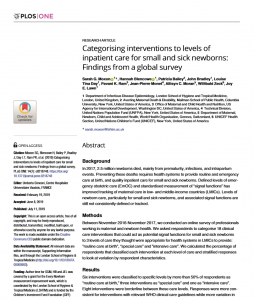
Background
In 2017, 2.5 million newborns died, mainly from prematurity, infections, and intrapartum events. Preventing these deaths requires health systems to provide routine and emergency care at birth, and quality inpatient care for small and sick newborns. Defined levels of emergency obstetric care (EmOC) and standardised measurement of “signal functions” has improved tracking of maternal care in low- and middle-income countries (LMICs). Levels of newborn care, particularly for small and sick newborns, and associated signal functions are still not consistently defined or tracked.
Methods
Between November 2016-November 2017, we conducted an online survey of professionals working in maternal and newborn health. We asked respondents to categorise 18 clinical care interventions that could act as potential signal functions for small and sick newborns to 3 levels of care they thought were appropriate for health systems in LMICs to provide: “routine care at birth”, “special care” and “intensive care”. We calculated the percentage of respondents that classified each intervention at each level of care and stratified responses to look at variation by respondent characteristics.
Results
Six interventions were classified to specific levels by more than 50% of respondents as “routine care at birth,” three interventions as “special care” and one as “intensive care”. Eight interventions were borderline between these care levels. Responses were more consistent for interventions with relevant WHO clinical care guidelines while more variation in respondents’ classification was observed in complex interventions that lack standards or guidelines. Respondents with experience in lower-income settings were more likely to assign a higher level of care for more complex interventions.
Conclusions
Results were consistent with known challenges of scaling up inpatient care in lower-income settings and underline the importance of comprehensive guidelines and standards for inpatient care. Further work is needed to develop a shortlist of newborn signal functions aligned with emergency obstetric care levels to track universal health coverage for mothers and their newborns.